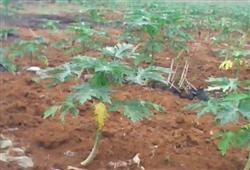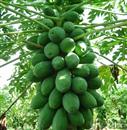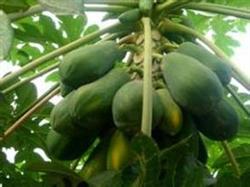Planting and management of Xuan papaya

[summary] Xuan papaya has the functions of relaxing muscles and activating collaterals, calming the liver and stomach, collecting lungs and dispelling dampness and heat. Main treatment of rheumatoid arthritis, waist and knee pain, limb numbness, gastrocnemius spasm, heatstroke vomiting and diarrhea, beriberi swelling and pain. Mainly produced in Xuancheng, Anhui and Sichuan, Hubei, Zhejiang, Henan, Hunan, Jiangxi and other places. [habits] like a humid and warm climate, which requires an environment with plenty of sunshine and rainfall. The requirement of soil is not strict, but it is better to use deep, loose, fertile and moist sandy loam and sandy soil with good drainage. Xuan papaya has developed root system, strong drought tolerance and tolerance to severe cold and high temperature. It is generally suitable to be cultivated in low mountain and hilly areas. [planting technology] 1. Propagation is mainly by cutting, and it can also be propagated by tillering and pressing. The main results are as follows: (1) cutting propagation can be carried out in spring, summer and winter. Spring germinates from February to March, and summer takes place during the Meiyu season from June to July. However, the seedling rate of cuttage in winter is high. The method of fully closed sand bed and moisturizing cuttings was used for winter cutting. The fully closed moisturizing cutting method was selected at the end of autumn and the beginning of winter. At the end of autumn and the beginning of winter, loose and fertile sandy soil was selected as the inserting bed, and after deep turning, sufficient base fertilizer was applied, leveled and raked fine, making a high border with a length of 8 meters, a width of 1.3 meters and a depth of 0.3 meters, and the border surface was wet by spraying water. When cutting, select the hard branches of the previous year, fully developed, pest-free and completely lignified, with a diameter of 0.5 cm and 0.8 cm, and cut into cuttings with more than 3 sprouts with a length of 15 cm and 20 cm. Then the lower end of the proximal node was cut into a horseear-shaped bevel, and the lower end of the slope was quickly dipped in 50 pm rooting powder (ABT) or 500-1000ppm naphthalene acetic acid solution for 10 seconds, dried slightly and then cut. (2) the tillering ability of Xuan papaya is very strong, and there are many tillering seedlings around the rhizosphere. From September to November, the seedlings with a height of more than 60 cm and strong growth can be dug with roots and immediately planted on the whole planting ground, the survival rate is very high, but the propagation coefficient is low. (3) the striping is propagated in spring and autumn every year, and the sturdy, pest-free branches close to the ground are bent, pressed into the soil, cut or scratched in the part of the branches, fixed with bamboo branches, then buried tightly in the pile, and then applied with appropriate amount of soil and miscellaneous fertilizer. After taking root and sprouting, it is cut off from the mother, dug with roots, and planted separately. 2. Soil preparation and planting (1) soil preparation and cutting seedbed should be selected with flat, sunny, fertile, loose and well drained sandy soil, which is easy to root after planting. There should be a source of water near the seedbed for irrigation. Planting land, it is appropriate to choose leeward to the sun, medium fertility and gentle slope low mountain or hilly land. It can also be planted sporadically on flat land or at the foot of the mountain, by the edge of the field, beside the ditch, and in the open space of the courtyard. Windy areas facing north are not suitable for planting. (2) planting can be carried out from defoliation in winter to sprouting in early spring. When planting, dig planting holes according to the row spacing of 2x 2m (165 plants / mu), hole diameter and depth of 50 cm, first dig loose subsoil to level, and then apply rotten barnyard manure, compost, cake fertilizer, fire soil ash and other fertilizers to mix evenly with the subsoil to make base fertilizer, each hole into 5Ling 10 kg, cover fine soil thickness of about 10 cm. Then, one strong seedling or two seedlings were planted in each hole to make the root system stretch in the hole and compacted with layered filling. After planting, the water is watered once, and the covered soil is 10ml 20cm higher than the ground, so that it is in the shape of a tortoise back, which is beneficial to heat preservation and anti-freezing to facilitate survival. 3. Field management (1) after ploughing, weeding and fertilization, dwarf crops can be interplanted between rows in the first two years, and weeding and fertilization can be carried out once a year in spring, summer and autumn. Each plant was put into stable manure, compost, calcium superphosphate, fire soil ash and other mixed composting compound fertilizer 10mur20kg. Open an annular ditch under the outer edge of the crown and cover the soil. The plant will be removed after the plant is sealed. (2) after pruning and planting, 6 stems with strong growth were selected from the clump and cultivated into natural happy plants. Pruning and pruning is carried out every winter to cut off withered branches, weak branches, old branches, overgrown branches, disease and insect branches and overgrown branches. It is appropriate for papaya to bear fruit on 2-year-old branches, so it should be cut short after fruit harvest every autumn, that is, about 30 cm long branches should be retained and the top tips should be cut off to promote multiple branches and blossom and bear fruit. Through several years of pruning and pruning, a high-yielding tree is formed, which is hollow in the outer circle, ventilated and transparent, the branches are sparse, strong, and can bear fruit both inside and outside. (3) after drainage and irrigation water is planted, attention should be paid to watering and protecting seedlings in case of dry weather. Timely dredging and drainage in the rainy season to prevent stagnant water and rotting roots.
- Prev

Cultivation techniques of Chaenomeles sinensis
Wild papaya is a deciduous shrub or small tree of Rosaceae, also known as Tiejiao pear, papaya, etc. Enjoying the laudatory name of "fruit of hundred benefits", it can produce more than 200 varieties of beverages, foods, health care products, medicines, cosmetics, beverages and pigments in eight categories. In recent years, Guizhou Province gradually strengthen industrial restructuring, vigorously develop "green...
- Next

Protective measures of cold resistance and anti-freezing in papaya cultivation
Papaya is a tropical crop, like hot climate, avoid low-temperature frost. Freezing injury occurs when the temperature is lower than 5 ℃. It is very important to take the following measures to prevent freezing: re-application of overwintering fertilizer. Each tree is treated with 10kg of organic fertilizer mixed with mature human and animal manure and plant ash, and 1.5 kg of phosphate fertilizer. At 80cm and 100cm from the trunk, dig 2.
Related
- Moge, come on! The staff of the peasant association in the producing area of cantaloupe were frightened when the crowd gathered.
- Causes and Solutions of low Fruit setting rate of Apple
- Symptoms and control measures of passion fruit virus disease
- Fruit growing lesson: how do apple orchards keep high yields?
- Can you build orchards in the mountains? What are the pros and cons?
- How to manage the coloring period of Crisson grape?
- This paper introduces the processing technology of two kinds of fig products.
- How much is a month for retired teachers in rural areas by 2020?
- How can strawberry planting increase sugar content? We should pay attention to management in many aspects.
- What are the cultivation techniques on how to improve the yield of golden fruit?

